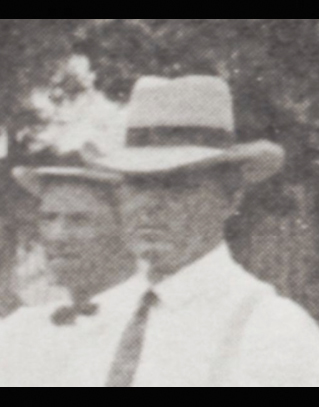
Robert J. Cobb, one of the largest farmers in Pitt County (800 acres of tobacco, 2000 acres owned), served the East Carolina board of trustees briefly, from 1908 until 1909, as its treasurer. Cobb was not, however, strictly speaking, an appointed member of the board. His local prominence as a wealthy businessman, building contractor, and generous supporter of educational initiatives no doubt recommended him for service to the board.
To ensure regional representation, the charter appointees to the board represented the congressional districts of the East, with Thomas Jarvis (1836-1915) and John B. Leigh (1862-1943) representing the first district. Archibald McDowell (1861-1940) and Yancey T. Ormond (1858-1922) represented the second district; John C. Parker (1845-1917) and John Robert Bannerman (1854-1935), the third; Ira T. Turlington (1859-1918) and Robert B. White (1876-1949), the fourth; and James Ozborn Carr (1869-1949), the sixth. C. W. Wilson (1867-1922) was named an officer of the board, serving as secretary. At the first meeting of the. ECTTS board, held in Jarvis’ law office in Greenville on March 10, 1908, Cobb was named treasurer.
Cobb was born into a farm family in Pitt County, receiving little education other than that available in rural schools during and shortly after the Civil War. In addition to farming, his father, James C. Cobb (1822-1905), opened a country store in the 1870s which was sufficiently successful for him to open another in Greenville in 1890. Robert J. Cobb managed the new store which soon proved a success. The following year, Cobb partnered with O. L. Joyner to build Greenville’s first tobacco warehouse, the Greenville Warehouse Company. The latter reportedly “gave birth to an industry that has turned millions of dollars into the community and transformed Greenville from a county village into a striving and progressive town.”
A decade later, in 1900, Cobb sold his interest in the warehouse, was elected a Board of Alderman, and invested in the newly organized Greenville Banking and Trust Company. In 1902, Cobb partnered with C. V. York (1876-1941) to organize the Building and Lumber Company of Greenville, later known as York & Cobb, and was named its first president.
In 1903, when the local bond initiative for the Greenville Graded School on Evans Street stalled, Cobb reportedly stepped forward and purchased a large portion of the remaining bonds, helping uplift, through his substantial investment, Greenville’s educational profile years before the founding of ECTTS.
In 1907, York & Cobb built the sizable Methodist Church in downtown Greenville, later named after Thomas Jarvis, and in 1908, was awarded the contract for the first four buildings on the ECTTS campus. In the 1908 photo of the ECTTS groundbreaking, Robert J. Cobb is pictured (far right), alongside Charles Vance “C.V.” York (1876-1941), his business partner, and Cecil Robert Cobb (1891-1967), his son. Cobb’s daughter, Irma Cobb Dunn (1888-1954), is also in the groundbreaking photograph (third left of Jarvis). No other family was as well-represented in the groundbreaking photo as that Robert J. Cobb. Interestingly, though Jarvis’ iconic stance with the groundbreaking shovel was the center of the photo, no one other than Cobb, though on the far right, stood closer to the camera, well in front of the axis otherwise defined by Jarvis.
Cobb eventually sold his interest in York & Cobb and invested in another undertaking, the Cabinet and Veneer Company. He also retained interests in large farming operations in the county. By the time of his passing in 1928, Cobb’s impact on Greenville’s economic and educational development was perhaps second only to that of Jarvis.
Sources:
- “Board of Trustees.” First Annual Catalogue of the East Carolina Teachers’ Training School, 1909-1910. P. 6. University Archives # UA45.03.03.03. J. Y. Joyner Library. East Carolina University. Greenville, North Carolina. https://digital.lib.ecu.edu/6033
- Bratton, Mary Jo Jackson. East Carolina University: The Formative Years, 1907-1982. Greenville, N.C.: East Carolina University Alumni Association, 1986. P. 73, 488.
- “Groundbreaking of ECTTS.” University Archives # UA55.01.4893. J. Y. Joyner Library. East Carolina University. Greenville, North Carolina. https://digital.lib.ecu.edu/23443
- King, Henry T. “Cobb, Robert James.” Sketches of Pitt County. Era Press, 1976. Pp. 240-231.
- “Eastern Training School: The Board of Trustees Named by Board of Education.” North Carolinian. March 28, 1907. P. 8.
- Joyner, Andrew. “Farmers in the County of Pitt.” Farmer and Mechanic. August 13, 1907. P. 1.
- “Minutes of the Board of Trustees of East Carolina Teachers Training School,” March 11, 1908. University Archives. J. Y. Joyner Library. East Carolina University. Greenville, N.C. Quoted from Bratton, East Carolina University, p. 489.
- “To Begin Work At Once.” News and Observer. April 15, 1910. P. 2.
- “Tobacco – Pitt County’s Golden Crop.” Greenville News. August 18, 1917. P. 1.
-
York Properties. https://yorkproperties.com/about-us/
Citation Information
Author: John A. Tucker, PhD
Date of Publication: 9/14/2022